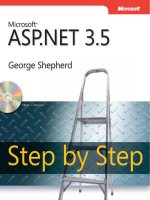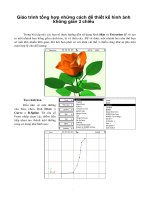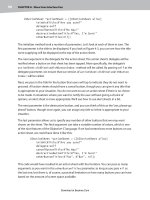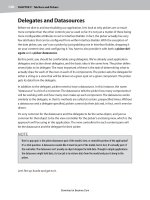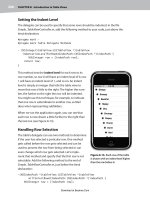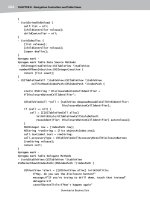more iphone 3 development phần 1 doc
Bạn đang xem bản rút gọn của tài liệu. Xem và tải ngay bản đầy đủ của tài liệu tại đây (10.35 MB, 58 trang )
COMPANION eBOOK SEE LAST PAGE FOR DETAILS ON $10 eBOOK VERSION
US $39.99
Shelve in:
Mobile Computing/Mac Development
User level:
Intermediate–Advanced
www.apress.com
SOURCE CODE ONLINE
BOOKS FOR PROFESSIONALS BY PROFESSIONALS
®
this print for content only—size & color not accurate
CYAN
MAGENTA
YELLOW
BLACK
PANTONE 123 C
SPOT MATTE
ISBN 978-1-4302-2505-8
9 7814
30 225058
5 39 9 9
I
nterested in iPhone development? Want to learn more? Whether you’re a
self taught iPhone dev or have just made your way through the pages of
Beginning iPhone 3 Development, we’ve got a great new book for you.
More iPhone 3 Development: Tackling iPhone SDK 3 digs deep into Apple’s latest
SDK, with bestselling authors Dave Mark and Je LaMarche explaining things
as only they can, covering topics like Core Data, peer-to-peer networking us-
ing GameKit and network streams, working with data from the web, MapKit,
in-application e-mail, and more. All the concepts and APIs are clearly laid out
and come complete with code snippets you can customize for use in your
most ambitious apps.
More iPhone 3 Development continues right where Beginning iPhone 3 Develop-
ment left o, starting with a series of chapters devoted to Core Data, Apple’s
new standard for iPhone Persistence. Je and Dave step you through the key
concepts of Core Data, including techniques and tips specically for writing
Large-Scale Applications. For writing professional iPhone apps, you’ll want
to embrace Core Data,.
The depth and breadth of Core Data coverage alone is worth the price of ad-
mission, but there’s so much more. This book covers a variety of networking
mechanisms, from GameKit’s relatively simple BlueTooth peer-to-peer model,
to the addition of Bonjour discovery and network streams, through the com-
plexity of acquiring information through Web File Access. Dave and Je also
take you through advanced topics, such as Concurrent Programming and
techniques for Debugging.
Your knowledge of iPhone app creation can’t be considered complete until
you’ve mastered all the knowledge imparted and techniques revealed in More
iPhone 3 Development.
Dave Mark is a long-time Mac developer and author and has written a num-
ber of books on Macintosh development, including Learn C on the Macintosh,
The Macintosh Programming Primer series, and Ultimate Mac Programming. His
blog can be found at www.davemark.com.
Je LaMarche is a longtime Mac developer, and Apple iPhone
Developer. With over 20 years of programming experience, he’s written
on Cocoa and Objective-C for MacTech Magazine, as well as articles
for Apple’s Developer Technical Services website. He has experience
working in Enterprise software, both as a developer for PeopleSoft
starting in the late 1990s, and then later as an independent consultant.
Trim: 7.5 x 9.25 spine = 0.000" 000 page count
Mark
More iPhone 3 Development
Companion
eBook
Available
More Great iPhone API
Coverage, Depth, and Insight
More
iPhone 3 Development
Tackling iPhone SDK 3
Dave Mark
|
Jeff LaMarche
RELATED TITLES
By the best-selling authors of
Beginning
iPhone Development
i
More iPhone 3
Development:
Tackling iPhone SDK 3
■ ■ ■
Dave Mark
Jeff LaMarche
ii
More iPhone 3 Development: Tackling iPhone SDK 3
Copyright © 2009 by Dave Mark and Jeff LaMarche
All rights reserved. No part of this work may be reproduced or transmitted in any form or by any means, electronic
or mechanical, including photocopying, recording, or by any information storage or retrieval system, without the
prior written permission of the copyright owner and the publisher.
ISBN-13 (pbk): 978-1-4302-2505-8
ISBN-13 (electronic): 978-1-4302-2743-4
Printed and bound in the United States of America 9 8 7 6 5 4 3 2 1
Trademarked names may appear in this book. Rather than use a trademark symbol with every occurrence of a
trademarked name, we use the names only in an editorial fashion and to the benefit of the trademark owner, with
no intention of infringement of the trademark.
President and Publisher: Paul Manning
Lead Editor: Clay Andres
Developmental Editor: Douglas Pundick
Technical Reviewer: Mark Dalrymple
Editorial Board: Clay Andres, Steve Anglin, Mark Beckner, Ewan Buckingham, Gary Cornell, Jonathan Gennick,
Jonathan Hassell, Michelle Lowman, Matthew Moodie, Duncan Parkes, Jeffrey Pepper, Frank Pohlmann,
Douglas Pundick, Ben Renow-Clarke, Dominic Shakeshaft, Matt Wade, Tom Welsh
Coordinating Editor: Kelly Moritz
Copy Editor: Marilyn Smith and Ralph Moore
Compositor: MacPS, LLC
Indexers: John Collin and Julie Grady
Artist: April Milne
Cover Designer: Anna Ishchenko
Distributed to the book trade worldwide by Springer-Verlag New York, Inc., 233 Spring Street, 6th Floor, New York,
NY 10013. Phone 1-800-SPRINGER, fax 201-348-4505, e-mail , or visit
.
For information on translations, please e-mail , or visit .
Apress and friends of ED books may be purchased in bulk for academic, corporate, or promotional use. eBook
versions and licenses are also available for most titles. For more information, reference our Special Bulk Sales–
eBook Licensing web page at
The information in this book is distributed on an “as is” basis, without warranty. Although every precaution has
been taken in the preparation of this work, neither the author(s) nor Apress shall have any liability to any person or
entity with respect to any loss or damage caused or alleged to be caused directly or indirectly by the information
contained in this work.
The source code for this book is available to readers at . You will need to answer questions
pertaining to this book in order to successfully download the code.
iii
To Deneen, Daniel, Kelley, and Ryan, LFU4FRNMWWA. . .
—Dave
To the most important people in my life, my wife and kids.
—Jeff
iv
Contents at a Glance
■Contents at a Glance iv
■Contents v
■About the Authors xii
■About the Technical Reviewer xiii
■Acknowlegments xiv
■Preface xv
■Chapter 1: Here We Go Round Again 1
Part I: Core Data 7
■Chapter 2: The Anatomy of Core Data 9
■Chapter 3: A Super Start: Adding, Displaying, and Deleting Data 41
■Chapter 4: The Devil in the Detail View 83
■Chapter 5: Preparing for Change: Migrations and Versioning 127
■Chapter 6: Custom Managed Objects 137
■Chapter 7: Relationships, Fetched Properties, and Expressions 169
Part II: Further Explorations 223
■Chapter 8: Peer-to-Peer Over Bluetooth Using GameKit 225
■Chapter 9: Online Play: Bonjour and Network Streams 271
■Chapter 10: Working with Data from the Web 329
■Chapter 11: MapKit 359
■Chapter 12: Sending Mail 391
■Chapter 13: iPod Library Access 405
■Chapter 14: Keeping Your Interface Responsive 451
■Chapter 15: Debugging 495
■Chapter 16: The Road Goes Ever On… 527
■Index 531
v
Contents
■Contents at a Glance iv
■Contents v
■About the Authors xii
■About the Technical Reviewer xiii
■Acknowledgments xiv
■Preface xv
■Chapter 1: Here We Go Round Again 1
What This Book Is 1
What You Need to Know 1
What You Need Before You Can Begin 2
What’s In this Book 4
Are You Ready? 6
Part I: Core Data 7
■Chapter 2: The Anatomy of Core Data 9
A Brief History of Core Data 10
Creating a Core Data Template Application 10
Core Data Concepts and Terminology 12
The Data Model and Persistent Store 13
The Data Model Class: NSManagedObjectModel 14
The Persistent Store and the Persistent Store Coordinator 16
Reviewing the Data Model 18
Entities and the Data Model Editor 18
Entities 18
Properties 19
Managed Objects 21
Key-Value Coding 21
Managed Object Context 22
Saves on Terminate 23
■ CONTENTS
vi
Loading Data from the Persistent Store 24
The Fetched Results Controller 26
Creating a Fetched Results Controller 26
The Fetched Results Controller Delegate Methods 29
Retrieving a Managed Object from the Fetched Results Controller 36
Creating and Inserting a New Managed Object 36
Deleting Managed Objects 38
Putting Everything in Context 39
■Chapter 3: A Super Start: Adding, Displaying, and Deleting Data 41
Setting up the Xcode Project 42
Application Architecture 43
Modifying the Application Delegate Interface 44
Adding to the Application Delegate Implementation 45
Creating the Table View Controller 46
Setting up MainWindow.xib 47
Connecting the Outlets 50
Designing the Data Model 50
Adding an Entity 51
Editing the New Entity 52
Adding Attributes to the New Entity 54
Adding the Name Attribute 54
Editing the Attribute 55
Creating HeroListViewController 60
Declaring the Fetched Results Controller 60
Drag Two Icons to Your Project 63
Designing the HeroListViewController Interface 64
Implementing the Hero View Controller 66
Let ‘Er Rip 79
Done, but Not Done 81
■Chapter 4: The Devil in the Detail View 83
Table-Based vs. Nib-Based Detail Views 84
Detail Editing View Challenges 85
Controlling Table Structure with Arrays 87
Paired Arrays 87
Nested Arrays 88
Paired Nested Arrays 89
Representing Our Table Structure with Arrays 89
Nested Arrays, Categorically Speaking 90
Updating the SuperDB Project 90
Formatting of Attributes 92
Creating the Detail View Controller 94
Declaring Instance Variables and Properties 96
Implementing the Viewing Functionality 97
Using the New Controller 103
Trying Out the View Functionality 106
Adding Editing Subcontrollers 107
Creating the Superclass 108
Creating the String Attribute Editor 112
Creating the Date Attribute Editor 115
Using the Attribute Editors 118
■ CONTENTS
vii
Implementing a Selection List 120
Creating the Generic Selection List Controller 120
Devil’s End 125
■Chapter 5: Preparing for Change: Migrations and Versioning 127
About Data Models 128
Data Models Are Compiled 128
Data Models Can Have Multiple Versions 129
Data Model Version Identifiers 131
Using the Versioned Data Model 132
Migrations 133
Lightweight vs. Standard 134
Standard Migrations 134
Setting up Your App to Use Lightweight Migrations 134
Time to Migrate On 136
■Chapter 6: Custom Managed Objects 137
Updating the Data Model 140
Adding the Age Attribute 141
Adding the Favorite Color Attribute 141
Adding a Minimum Length to the Name Attribute 142
Creating the Hero Class 143
Tweaking the Hero Header 145
Defaulting 146
Validation 147
Single-Attribute Validations 148
Multiple-Attribute Validations 150
Virtual Accessors 151
Adding Validation Feedback 152
Updating the ManagedObjectAttributeEditor Header File 152
Updating the ManagedObjectAttributeEditor Implementation File 153
Updating the Subclasses to Use Validation 154
Creating the Value Transformer 155
Creating the Color Attribute Editor 158
Displaying the New Attributes in Hero Edit Controller 161
The Display Problem 163
Adding View-Only Support to Hero Edit Controller 165
Hiding the Disclosure Indicator 165
Handling Taps on Read-Only Attributes 166
Color Us Gone 167
■Chapter 7: Relationships, Fetched Properties, and Expressions 169
Expanding Our Application: Superpowers and Reports 170
Relationships 172
To-One Relationships 173
To-Many Relationships 174
Inverse Relationships 176
Delete Rules 177
Fetched Properties 178
Creating Relationships and Fetched Properties in the Data Model Editor 179
Adding the Power Entity 179
Creating the Powers Relationship 180
■ CONTENTS
viii
Creating the Inverse Relationship 181
Creating the olderHeroes Fetched Property 181
Creating the youngerHeroes Fetched Property 185
Creating the sameSexHeroes Fetched Property 186
Creating the oppositeSexHeroes Fetched Property 187
Adding Relationships and Fetched Properties to the Hero Class 189
The Big Refactor 190
Renaming the Class 191
Refactoring the hero Instance Variable 193
Removing the Arrays 193
Supporting Save and Cancel Buttons 193
Adding Support for To-Many Relationships 197
Using the New Generic Controller 211
Adding Factory Methods for Hero and Power 211
Deleting the Nib Instance 215
Updating HeroListController 215
Creating the Fetched Property Attribute Controller 216
Cleaning Up Deleted Objects 218
Wonderful to the Core 221
Part II: Further Explorations 223
■Chapter 8: Peer-to-Peer Over Bluetooth Using GameKit 225
This Chapter’s Application 226
Network Communication Models 229
Client-Server Model 229
Peer-to-Peer Model 230
Hybrid Client-Server/Peer-to-Peer 231
The GameKit Session 232
Creating the Session 232
Finding and Connecting to Other Sessions 233
Listening for Other Sessions 234
Sending Data to a Peer 234
Packaging Up Information to Send 235
Receiving Data from a Peer 236
Closing Connections 237
The Peer Picker 237
Creating the Peer Picker 237
Handling a Peer Connection 238
Creating the Session 238
Creating the Project 239
Turning Off the Idle Timer 239
Importing the GameKit Framework 240
Designing the Interface 241
Trying It Out 268
Game On! 269
■Chapter 9: Online Play: Bonjour and Network Streams 271
This Chapter’s Application 271
Overview of the Process 273
Setting Up a Listener 273
Callback Functions and Run Loop Integration 274
■ CONTENTS
ix
Configuring a Socket 275
Specifying a Port for Listening 277
Registering the Socket with the Run Loop 280
Implementing the Socket Callback Function 280
Stopping the Listener 281
Bonjour 281
Creating a Service for Publication 282
Searching for Published Bonjour Services 285
Browser Delegate Methods 286
Resolving a Discovered Service 287
Streams 288
Opening a Stream 289
The Stream and Its Delegate 289
Receiving Data from a Stream 290
Sending Data Through the Stream 291
Putting It All Together 292
Updating Tic-Tac-Toe for Online Play 292
Adding the Packet Categories 293
Implementing the Online Session Object 295
Creating the Listener Object 306
Creating the Peer Browser 311
Updating TicTacToeViewController to Support Online Play 318
Time to Play 328
■Chapter 10: Working with Data from the Web 329
Setting Up the Application Skeleton 331
Declaring Actions and Outlets 331
Designing the Interface 333
Implementing the Stubs 335
Retrieving Data Using Foundation Objects 336
Retrieving Data Synchronously 339
The URL Request 339
Retrieving Data Asynchronously 344
NSURLConnection Delegate Methods 345
Adding Asynchronous Retrieval to WebWorks 346
Request Types and Form Parameters 350
Specifying the HTTP Request Types 350
Form Parameters 351
Building the RequestTypes Application 353
404 Conclusion Not Found 358
■Chapter 11: MapKit 359
This Chapter’s Application 360
Overview and Terminology 361
The Map View 362
Map Types 362
User Location 364
Coordinate Regions 364
Setting the Region to Display 367
The Map View Delegate 367
Annotations 369
The Annotation Object 370
■ CONTENTS
x
The Annotation View 370
Adding and Removing Annotations 371
Selecting Annotations 372
Providing the Map View with Annotation Views 372
Reverse Geocoding 373
Building the MapMe Application 375
Declaring Outlets and Actions 375
Building the Interface 376
Writing the Annotation Object Class 378
Implementing MapMeViewController 381
Linking the Map Kit and Core Location Frameworks 389
Go East, Young Programmer 390
■Chapter 12: Sending Mail 391
This Chapter’s Application 391
The MessageUI Framework 394
Creating the Mail Compose View Controller 394
Prepopulating the Subject Line 394
Prepopulating Recipients 394
Setting the Message Body 395
Adding Attachments 395
Presenting the Mail Compose View 395
The Mail Compose View Controller Delegate Method 395
Building the MailPic Application 396
Declaring Outlets and Actions 397
Building the User Interface 397
Implementing the View Controller 398
Linking the MessageUI Framework 403
Mailing It In… 403
■Chapter 13: iPod Library Access 405
This Chapter’s Application 405
Working with the iPod Library 407
Media Items 408
Media Item Collections 413
Media Queries and Media Property Predicates 414
The Media Picker Controller 417
The Music Player Controller 418
Building the Simple Player Application 424
Adding Media Item Collection Functionality 424
Declaring Outlets and Actions 428
Building the User Interface 430
Implementing the Simple Player View Controller 434
Taking Simple Player for a Spin 448
Avast! Rough Waters Ahead! 448
■Chapter 14: Keeping Your Interface Responsive 451
Exploring the Concurrency Problem 453
Creating the Stalled Application 454
Declaring Actions and Outlets 454
Designing the Interface 454
Implementing the Stalled View Controller 455
■ CONTENTS
xi
Timers 458
Creating a Timer 458
Stopping a Timer 459
Limitations of Timers 459
Fixing Stalled with a Timer 460
Creating the Batch Object 460
Updating the Controller Header 462
Updating the Nib 463
Updating the View Controller Implementation 463
Operation Queues & Concurrency 468
Threads 469
Operations 475
Operation Queues 478
Fixing Stalled with an Operation Queue 479
Creating SquareRootApplication 480
Changes to StalledViewController.h 485
Adjusting the User Interface 486
Updating StalledViewController.m 487
Queue ’em Up 493
■Chapter 15: Debugging 495
The Debugger 496
Breakpoints 497
The GDB Console 513
Static Analysis 516
Specific Bugs 517
Overreleasing Memory 517
Infinite Recursion 523
Missed Outlet and Action Connections 525
GDB: Stopped at Concluding Paragraph 525
■Chapter 16: The Road Goes Ever On… 527
Getting Unstuck 527
Apple’s Documentation 528
Mailing Lists 528
Discussion Forums 528
Web Sites 529
Blogs 529
And If All Else Fails… 530
Farewell 530
■Index 531
xii
About the Authors
Dave Mark is a longtime Mac developer and author, who has written a number of books on
Mac development, including Beginning iPhone 3 Development (Apress, 2009), Learn C on the
Mac (Apress, 2008), The Macintosh Programming Primer series (Addison-Wesley, 1992), and
Ultimate Mac Programming (Wiley, 1995). Dave loves the water and spends as much time as
possible on it, in it, or near it. He lives with his wife and three children in Virginia.
Jeff LaMarche is a Mac and iPhone developer with more than 20 years of programming
experience. This is his second book on iPhone development. He has also written about Cocoa
and Objective-C for MacTech Magazine, as well as articles for Apple’s Developer Technical
Services web site. He has experience working in enterprise software as a developer for
PeopleSoft, starting in the late 1990s, and later as an independent consultant. He now focuses
exclusively on programming for the Mac and iPhone.
xiii
About the Technical Reviewer
Mark Dalrymple is a longtime Mac and Unix programmer, working on cross-platform toolkits,
Internet publishing tools, high-performance web servers, and end-user desktop applications.
He is also the principal author of Advanced Mac OS X Programming (Big Nerd Ranch, 2005) and
Learn Objective-C on the Mac (Apress, 2009). In his spare time, Mark plays trombone and
bassoon, and makes balloon animals.
xiv
Acknowledgments
This book could not have been written without our mighty, kind, and clever families, friends, and cohorts. First and
foremost, eternal thanks to Terry and Deneen for putting up with us, and for keeping the rest of the universe at bay
while we toiled away on this book. This project saw us tucked away in our writers’ cubby for many long hours, and
somehow, you didn’t complain once. We are lucky men.
This book could not have been written without the fine folks at Apress. Clay Andres brought us to Apress in the first
place and carried this book on his back. Dominic Shakeshaft was the gracious mastermind who dealt with all of our
complaints with a smile on his face, and somehow found solutions that made sense and made this book better.
Kelly Moritz, our wonderful and gracious coordinating editor, was the irresistible force to our slowly movable
object. Douglas Pundick, our developmental editor, helped us with some terrific feedback along the way. They kept
the book on the right track and always pointed in the right direction. Marilyn Smith and Ralph Moore, copy editors
extraordinaire, you were both such a pleasure to work with! Jeffrey Pepper, Frank McGuckin, Angie MacAllister,
and the Apress production team took all these pieces and somehow made them whole. Leo Cuellar and Jeff
Stonefield assembled the marketing message and got it out to the world. To all the folks at Apress, thank you, thank
you, thank you!
A very special shout out to our incredibly talented technical reviewer, Mark Dalrymple. In addition to
providing insightful feedback, Mark tested all the code in this book, and helped keep us on the straight and
narrow. Thanks, Mark!
Finally, thanks to our children for their patience while their dads were working so hard. This book is for you,
Maddie, Gwynnie, Ian, Kai, Daniel, Kelley, and Ryan.
xv
Preface
The preface to our previous book, Beginning iPhone 3 Development, started with the phrase, “What an amazing
journey!” Well, it’s true. We’re having a blast, making a lot of new friends and, above all, learning, learning,
learning. The iPhone SDK continues to evolve, and with each new release, it brings new concepts to explore and
new design patterns to master.
As its name implies, More iPhone 3 Development assumes you’ve read Beginning iPhone 3 Development or one of
the other terrific titles out there, or have tackled the iPhone dev learning curve on your own. If you are a beginner,
not to worry, our approach is the same. We talk you through the concepts, and then build a new project and walk
you through the source code, with a sprinkling of tips and cautions along the way.
The book starts off with a series of chapters that cover Core Data, Apple’s official iPhone persistence framework. If
the concept of persistence is new to you, don’t be intimidated by the name. When you want your data to stick
around from one run of your app to the next, that’s persistence. Beginning iPhone 3 Development touched on the
topic with a brief introduction to Core Data, but More iPhone 3 Development starts from scratch and gives you a
complete tour through Core Data, with a lot of reusable code. By the time you are finished with the Core Data
chapters, you should have everything you need to add Core Data to your own iPhone apps.
Next up, we offer a series of chapters on GameKit and networking. The GameKit framework makes it easy to add
Bluetooth connectivity to your apps. We bring GameKit to life by building a simple, two-person game. We then
follow that up by taking iPhone networking to the next level, showing you how to expand your networking skill set
to include game play over a local area network. Once you’ve mastered those techniques, it’s just a short step to
adding Internet play. Our final networking chapter explores techniques for pulling data from the Internet and
interacting with web servers.
Those chapters cover the most widely requested topics by our readers. We hope you’ll find them worth the price of
admission. But wait, there’s more! We also cover MapKit, in-application e-mail, and adding iPod functionality to
your applications via the MediaPlayer framework. Finally, we wrap up things with chapters on concurrency and
debugging techniques.
Before we leave you to your reading, we just want to say how much we appreciate your support. You’ve truly made
this a gratifying experience for us both. As always, be sure to check out and drop
us a line to let us know about your amazing new apps. We look forward to seeing you on the forum. Happy coding!
Dave and Jeff
xvi
1
1
Chapter
Here We Go Round Again
So, you’re still creating iPhone applications, huh? Great! The iPhone and the App Store
have been a tremendous success, fundamentally changing the way mobile applications
are delivered and completely changing what people expect from their mobile phones.
Since the first release of the iPhone Software Development Kit (SDK) way back in March
2008, Apple has been busily adding new functionality and improving what was already
there. It’s no less exciting of a platform than it was back when it was first introduced. In
fact, in many ways, it’s more exciting, because Apple keeps expanding the amount of
functionality available to third-party developers like us.
What This Book Is
This book is a guide to help you continue down the path to creating better iPhone
applications. In Beginning iPhone 3 Development (Apress, 2009), our goal was to get
you past the initial learning curve, and to help you get your arms around the
fundamentals of building your first iPhone applications. In this book, we’re assuming you
already know the basics. So, in addition to showing you how to use several of the new
APIs introduced with iPhone SDK 3.0, we’re also going to weave in some more
advanced techniques that you’ll need as your iPhone development efforts grow in size
and complexity.
In Beginning iPhone 3 Development, every chapter was self-contained, each presenting
its own unique project or set of projects. We’ll be using a similar approach in the second
half of this book, but in Chapters 2 through 7, we’ll focus on a single, evolving Core Data
application. Each chapter will cover a specific area of Core Data functionality as we
expand the application. We’ll also be strongly emphasizing techniques that will keep
your application from becoming unwieldy and hard to manage as it gets larger.
What You Need to Know
This book assumes that you already have some programming knowledge and that you
have a basic understanding of the iPhone SDK, either because you’ve worked through
Beginning iPhone 3 Development or because you’ve gained a similar foundation from
1
CHAPTER 1: Here We Go Round Again
2
other sources. We assume that you’ve experimented a little with the SDK, perhaps
written a small program or two on your own, and have a general feel for how Xcode and
Interface Builder work.
COMPLETELY NEW TO THE IPHONE?
If you are completely new to iPhone development, there are other books you probably should read before
this one. If you don’t already understand the basics of programming and syntax of the C language, you
should check out Learn C on the Mac by Dave Mark (Apress, 2008), which is a comprehensive introduction
to the C language for Macintosh programmers:
If you already understand C, but don’t have any experience programming with objects, check out Learn
Objective-C on the Mac (Apress, 2009), an excellent and approachable introduction to Objective-C by Mac
programming experts Mark Dalrymple and Scott Knaster:
Next, navigate over to the Apple iPhone Development Center and download a copy of The Objective-C 2.0
Programming Language, a very detailed and extensive description of the language and a great reference
guide:
/>ObjectiveC/
Note that you’ll need to log in (we’ll get to registration in the next section) before you are taken to the start
of this document.
Once you have a firm handle on Objective-C, you need to master the fundamentals of the iPhone SDK. For
that, you should check out the prequel to this book, Beginning iPhone 3 Development (Apress 2008):
What You Need Before You Can Begin
Before you can write software for iPhone, you need a few things. For starters, you’ll
need an Intel-based Macintosh running Snow Leopard (Mac OS X 10.6.2 or later). Any
Macintosh computer—laptop or desktop—that has been released since 2006 should
work just fine, but make sure your machine is Intel-based and is capable of running
Snow Leopard.
NOTE: You actually can develop for the iPhone using Leopard (Mac OS X 10.5 or later), but there
are many great new features in Xcode that are available only on Snow Leopard. Therefore, we
highly recommend upgrading to Snow Leopard if you are using an earlier release.
This may seem obvious, but you’ll also need an iPhone or iPod touch. While much of
your code can be tested using the iPhone simulator, not all programs will run in the
CHAPTER 1: Here We Go Round Again
3
simulator. And you’ll want to thoroughly test any application you create on an actual
device before you ever consider releasing it to the public.
Finally, you’ll need to sign up to become a Registered iPhone Developer. Apple requires
this step before it will allow you to download the iPhone SDK. If you’re already a
Registered iPhone Developer, go ahead and download the latest and greatest iPhone
development tools, and skip ahead to the next section.
If you’re new to Apple’s Registered iPhone Developer programs, navigate to
which will bring you to a page similar to that
shown in Figure 1-1. Just below the iPhone Dev Center banner, on the right side of the
page, you’ll find links labeled Log in and Register. Click the Register link. On the page
that appears, click the Continue button. Follow the sequence of instructions to use your
existing Apple ID or create a new one.
Figure 1-1. Apple’s iPhone Dev Center web site
At some point, as you register, you’ll be given a choice of several paths, all of which will
lead you to the SDK download page. The three choices are free, commercial, and
enterprise. All three options give you access to the iPhone SDK and Xcode, Apple’s
integrated development environment (IDE). Xcode includes tools for creating and
CHAPTER 1: Here We Go Round Again
4
debugging source code, compiling applications, and performance-tuning the
applications you’ve written.
The free option is, as its name implies, free. It lets you develop iPhone apps that run on
a software-only iPhone simulator, but does not allow you to download those apps to
your iPhone or iPod touch, nor sell your apps on Apple’s App Store. In addition, some
programs in this book will run only on your device, not in the simulator, which means
you will not be able to run them if you choose the free solution. That said, the free
solution is a fine place to start if you don’t mind learning without doing for those
programs that won’t run in the simulator.
The other two options are to sign up for an iPhone Developer Program: either the
Standard (commercial) Program or the Enterprise Program. The Standard Program costs
$99. It provides a host of development tools and resources, technical support,
distribution of your application via Apple’s App Store, and, most important, the ability to
test and debug your code on an iPhone rather than just in the simulator. The Enterprise
Program, which costs $299, is designed for companies developing proprietary, in-house
applications for the iPhone and iPod touch. For more details on these two programs,
check out
NOTE: If you are going to sign up for the Standard or Enterprise Program, you should go do it
right now. It can take a while to get approved, and you’ll need that approval to be able to run
applications on your iPhone. Don’t worry, though—the projects in the early chapters of this book
will run just fine on the iPhone simulator.
Because iPhone is an always-connected mobile device that uses another company’s
wireless infrastructure, Apple has placed far more restrictions on iPhone developers than
it ever has on Macintosh developers, who are able to write and distribute programs with
absolutely no oversight or approval from Apple. Apple is not doing this to be mean, but
rather to minimize the chances of people distributing malicious or poorly written
programs that could degrade performance on the shared network. It may seem like a lot
of hoops to jump through, but Apple has gone through quite an effort to make the
process as painless as possible.
What’s In this Book
As we said earlier, Chapters 2 through 7 of this book focus on Core Data, Apple’s
primary persistence framework. The rest of the chapters cover specific areas of
functionality that are either new with iPhone SDK 3.0 or were simply too advanced to
include in Beginning iPhone 3 Development.
CHAPTER 1: Here We Go Round Again
5
Here is a very brief overview of the chapters that follow:
Chapter 2, The Anatomy of Core Data: In this chapter, we’ll introduce
you to Core Data. You’ll learn why Core Data is a vital part of your
iPhone development arsenal. We’ll dissect a simple Core Data
application and show you how all the individual parts of a Core Data-
backed application fit together.
Chapter 3, A Super Start: Adding, Displaying and Deleting Data: Once
you have a firm grasp on Core Data’s terminology and architecture,
you’ll learn how to do some basic tasks, including inserting, searching
for, and retrieving data.
Chapter 4, The Devil in the Detail View: In this chapter, you’ll learn how
to let your users edit and change the data stored by Core Data. We’ll
explore techniques for building generic, reusable views so you can
leverage the same code to present different types of data.
Chapter 5, Preparing for Change: Migrations and Versioning: Here,
we’ll look at Apple tools that you can use to change your application’s
data model, while still allowing your users to continue using their data
from previous versions of your application.
Chapter 6, Custom Managed Objects: To really unlock the power of
Core Data, you can subclass the class used to represent specific
instances of data. In this chapter, we’ll show you how to use custom
managed objects, as well as demonstrate some of the benefits of
doing so.
Chapter 7, Relationships, Fetched Properties, and Expressions: In this
final chapter on Core Data, we’ll cover some mechanisms that allow
you to expand your applications in powerful ways. We’ll also refactor
the application we’ve built in the previous chapters, so that we don’t
need to add new classes as we expand our data model.
Chapter 8, Peer-to-Peer Over Bluetooth Using GameKit: One of the
coolest new features of SDK 3.0 is the GameKit framework. This
framework makes it easy to create programs that communicate over
Bluetooth, such as multiplayer games for the iPhone and iPod touch.
We’ll explore GameKit by building a simple two-player game.
Chapter 9, Online Play: Bonjour and Network Streams: GameKit
doesn’t provide the ability to make multiplayer games that work over
Wi-Fi or the Internet. In this chapter, we’ll expand our simple two-
player game so it can also be played over non-Bluetooth networks.
Chapter 10, Working with Data from the Web: The iPhone is an
always-connected device, so learning how to pull data from the Web
or other places on the Internet can be very valuable. In this chapter,
we’ll look at several different techniques for interacting with web
servers.
CHAPTER 1: Here We Go Round Again
6
Chapter 11, MapKit: This chapter explores another great new piece of
functionality added to the iPhone SDK with the 3.0 release, MapKit.
This framework allows you to leverage Google Maps directly from your
application.
Chapter 12, Sending Mail: In the original iPhone SDK, if your
application wanted to send e-mail, it needed to launch the Mail
application to do so. Now, thanks to the 3.0 version, we have the
ability to send e-mail directly from our applications. We’ll show you
how to implement that functionality in this chapter.
Chapter 13, iPod Library Access: It’s now possible to programmatically
get access to your users’ complete library of audio tracks stored on
their iPhone or iPod touch. In this chapter, we’ll look at the various
techniques used to find, retrieve, and play music and other audio
tracks.
Chapter 14, Keeping Your Interface Responsive: Long-running
programming tasks can easily bog down the iPhone’s user interface.
In this chapter, we’ll take a look at implementing different forms of
concurrency so that your application remains responsive.
Chapter 15, Debugging: No program is ever perfect. Bugs and defects
are a natural part of the programming process. In this chapter, we’ll
cover various techniques for finding and fixing bugs in iPhone SDK
programs.
Chapter 16, The Road Goes Ever On…: Sadly, every journey must
come to an end. We’ll wrap up this book with fond farewells and some
resources we hope you’ll find useful.
Are You Ready?
As we said in Beginning iPhone 3 Development, iPhone is an incredible computing
platform, an ever-expanding frontier for your development pleasure. In this book, we’re
going to take you further down the iPhone development road, digging deeper into the
SDK, touching on new and, in some cases, more advanced topics.
Read the book, and be sure to build the projects yourself—don’t just copy them from
the archive and run them once or twice. You’ll learn most by doing. Make sure you
understand what you did, and why, before moving on to the next project. Don’t be afraid
to make changes to the code. Experiment, tweak the code, observe the results. Rinse
and repeat.
Got your iPhone SDK installed? Turn the page, put on some tunes, and let’s go. Your
continuing journey awaits.
Part
Core Data
Core Data is Apple’s framework for persisting data to the file system. Using Core Data,
you deal with your program’s data as objects, and let the framework deal with the gnarly
specifics of how to save, find, and retrieve those objects. Over the next several
chapters, you’ll see how to use Core Data so that you can develop your apps more
quickly and get better performance than with traditional persistence mechanisms.
I


